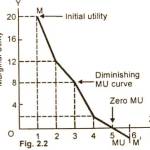Discussion at Cato Unbound over whether the Law of Diminishing Marginal Utility is an example of an a priori truth of economics. Alfred Marshall put the law this way: “the additional benefit which a person derives from a given increase of his stock of a thing, diminishes with every increase in the stock that he already has.”[1]
In my view, there are no a priori truths anywhere in the universe. But here I want to ask: Is the Law of Diminishing Utility even true? Returns diminish in many cases — but not all — and if diminishing returns is not universal, it can’t be a “law.”
 Here’s a standard example that supports the law. You’re hungry so you eat a piece of toast. You’re still hungry, so you eat another. And maybe one more. But while you could eat a fourth, you could as easily not bother. In this example, the utility you get from each piece of toast decreases: the first piece gives you much satisfaction, the second piece a little less, the third even less, and the fourth none.
Here’s a standard example that supports the law. You’re hungry so you eat a piece of toast. You’re still hungry, so you eat another. And maybe one more. But while you could eat a fourth, you could as easily not bother. In this example, the utility you get from each piece of toast decreases: the first piece gives you much satisfaction, the second piece a little less, the third even less, and the fourth none.
But what of this example? I am thirsty on a hot summer day, so I have a beer. I drink it quickly and hardly notice it going down. But I savor the second one, and drinking it gives me more pleasure than the first did. That’s increasing marginal utility. (In my case, if I were to have a third I would enjoy it much less and fall asleep soon after.)
Collectors are another example. Suppose I want to collect a set of ten lovely wine glasses, but I can’t afford to purchase them all at once, so I save money and purchase additional ones when I can afford to. But as each successive unit brings me closer to completing the set, the more pleasure I get from each additional wine glass and the amount I’m willing to pay for each may increase.[2]
The three examples give us variable utility curves. The toast example is a diminishing curve. The beer example’s curve initially increases before declining. The wine-glass collection is an increasing curve.
So is diminishing utility a “law,” or does the marginal utility vary from case to case depending on the product involved and the consumer’s needs? And if it depends, do we not have to investigate the facts of the case and not assume a priori a law that can be applied deductively?[3]
Notes:
[1] Alfred Marshall, Principles of Economics (1890), III.III.3.
[2] In the wine-glass-collector example I assume each unit is identical. Those collector cases are different from cases where each unit in the collection is also unique. For example, if I were to collect 20th-century Canadian dollar coins, each coin is a Canadian dollar but each year is a different date, and each coin’s unique date adds a complicating utility factor.
[3] Related earlier discussion: “Are Austrian economists anti-empirical?”
Hello Stephen, interest post about a very interesting topic.
If I may, I’d like to share a different interpretation of Marginal Utility (MU) that is related to the problem you mention.
The hungry/thirst examples are usually find in economic textbook, but I don’t think they are a good depiction of what MU stands for.
MU is about decreasing utility when satisfying *different* needs/preferences with similar goods, not about a physical good in itself. If I’m thirsty, and I need 3 glasses of water to satisfy my thirst, then I can’t apply MU to the first, second and third glass of water. MU says that the first unit of three glasses of water are highly value than the second bundle of three glasses of water. For instance, my preferences that can be satisfied with glasses of water could be:
1-. Thirst (for which I need 3 glasses of water).
2-. Wash my hands (for which I need 3 glasses of water).
3-. Water my plants (for which I need 3 glasses of water).
How many glasses of water I need to satisfy each one of them is different technical problem. Trying to fit MU in the first three glasses of water is like trying to fit MU when I buy first a wheel, then the doors, and then the engine of a car I’m buying by piece rather than complete. MU is the difference of utility between the first complete car and the second complete car (when the two cars are the same).
I think the same problem happens with the collection. Let’s say I want to complete a collection of 10 paintings. Then my preference is the collection set, not a stand alone painting. MU is about having the first collection of 10 paintings versus the utility of a second complete collection of paintings. MU is not about what happens with the willingness to pay for the 10th painting versus the first one, but about the willingness to pay for the whole first collection with respect to the second collection.
The three of them, Menger, Walras and Jevons were not very clear on this and, in fact, the food examples come from them. I think Bohm-Bawerk is much clear on this when he uses the bags of food that are applied to different (rather than the same) needs by a farmer. Regrettably, still today economic textbooks keep using erroneous examples of what is probably the most important law in the discipline!
Hope to see you again soon.
Best,
NC